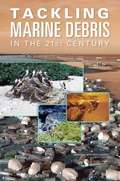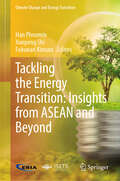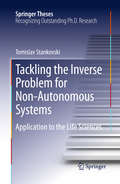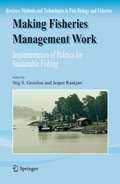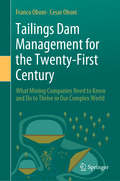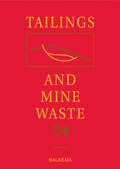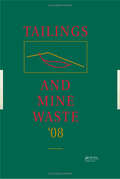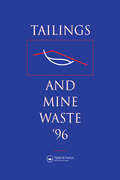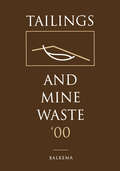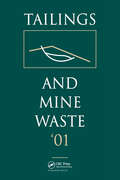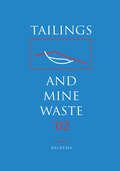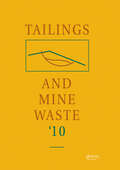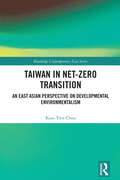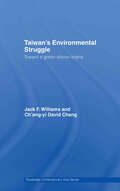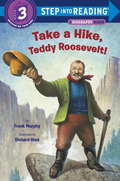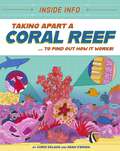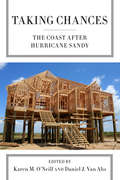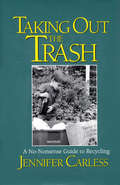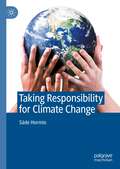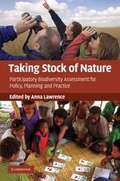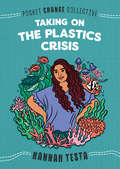- Table View
- List View
Tackling Marine Debris In The 21st Century
by National Research Council of the National AcademiesMarine debris from ships and other ocean-based sources-including trash and lost fishing gear-contributes to the spoiling of beaches, fouling of surface waters and the seafloor, and harm to marine animals, among other effects. Unfortunately, international conventions and domestic laws intended to control marine debris have not been successful, in part because the laws, as written, provide little incentive to change behavior. This book identifies ways to reduce waste, improve waste disposal at ports, and strengthen the regulatory framework toward a goal of zero waste discharge into the marine environment. Progress will depend on a commitment to sustained funding and appropriate institutional support. The Interagency Marine Debris Coordinating Committee should, through planning and prioritization, target research to understand the sources, fates, and impacts of marine debris. It should support the establishment of scalable and statistically rigorous protocols that allow monitoring at a variety of temporal and spatial scales. These protocols should contain evaluative metrics that allow assessment of progress in marine debris mitigation. The United States, through leadership in the international arena, should provide technical assistance and support for the establishment of additional monitoring and research programs worldwide.
Tackling the Energy Transition: Insights from ASEAN and Beyond (Climate Change and Energy Transition)
by Fukunari Kimura Xunpeng Shi Han PhouminThis book delves into the intricate dynamics of energy transitions within the ASEAN and East Asia region, focusing on the practical applications of various strategies. Through a series of insightful chapters, leading experts dissect key topics like carbon taxation, decarbonization, and the impact of energy transitions on carbon emissions, providing a nuanced understanding of the regional complexities. What sets this book apart is its pragmatic approach, offering concrete applications and policy implications. Each chapter not only explores theoretical aspects but also connects them with real-world scenarios, making this an essential guide for policymakers, practitioners, and scholars. The scope of the book is broad yet focused, covering diverse topics from carbon taxation and forest sustainability to the challenges of energy transition in smart cities and comparative assessments of electric vehicle technologies. It provides a comprehensive overview of the economic, political, and environmental facets of energy transitions in the region. Intended for a wide range of readers, including researchers, policymakers, industry professionals, and students, the book offers insights at an advanced level but remains accessible to those with a general interest in energy and environmental studies.
Tackling the Inverse Problem for Non-Autonomous Systems: Application to the Life Sciences
by Tomislav StankovskiThis thesis presents a new method for following evolving interactions between coupled oscillatory systems of the kind that abound in nature. Examples range from the subcellular level, to ecosystems, through climate dynamics, to the movements of planets and stars. Such systems mutually interact, adjusting their internal clocks, and may correspondingly move between synchronized and non-synchronized states. The thesis describes a way of using Bayesian inference to exploit the presence of random fluctuations, thus analyzing these processes in unprecedented detail. It first develops the basic theory of interacting oscillators whose frequencies are non-constant, and then applies it to the human heart and lungs as an example. Their coupling function can be used to follow with great precision the transitions into and out of synchronization. The method described has the potential to illuminate the ageing process as well as to improve diagnostics in cardiology, anesthesiology and neuroscience, and yields insights into a wide diversity of natural processes.
Tagging and Tracking of Marine Animals with Electronic Devices
by Alistair Hobday Molly Lutcavage Haritz Arrizabalaga Nuno Fragoso Jennifer L. Nielsen John SibertThe 2nd international tagging and tracking symposium was held in San Sebastian, Spain, in October 2007, seven years after the first symposium was held in Hawaii in 2000 (Sibert and Nielsen 2001). In the intervening seven years, there have been major advances in both the capability and reliability of electronic tags and analytical approaches for geolocation of tagged animals in marine habitats. Advances such as increased data storage capacity, sensor development, and tag miniaturization have allowed researchers to track a much wider array of marine animals, not just large and charismatic species. Importantly, data returned by these tags are now being used in population analyses and movement simulations that can be directly utilized in stock assessments and other management applications. Papers in this volume are divided into three sections, the first describing insights into behavior achieved using acoustic, archival, and novel tags, the second reporting on advances in methods of geolocation, while the final section includes contributions where tag data have been used in management of marine species. Accurate documentation of animal movements and behaviors in critical marine habitats are impossible to obtain with other technologies. The management and conservation of marine species are critical in today's changing ocean environment and as electronic tags become more accurate and functional for a diversity of organisms their application continues to grow, setting new standards in science and technology.
Tailings Dam Management for the Twenty-First Century: What Mining Companies Need to Know and Do to Thrive in Our Complex World
by Franco Oboni Cesar OboniThis book presents a comprehensive approach to address the need to improve the design of tailings dams, their management and the regulation of tailings management facilities to reduce, and eventually eliminate, the risk of such facilities failing. The scope of the challenge is well documented in the report by the United Nations Environment Program (UNEP) and GRID Arendal entitled “Mine Tailings Storage: Safety Is No Accident,” which was released in October 2017. The report recommends that “Regulators, industry and communities should adopt a shared, zero-failure objective to tailings storage facilities…” and identifies several areas where further improvements are required. In this context, the application of cutting-edge risk-assessment methodologies and risk-management practices can contribute to a significant reduction and eventual elimination of dam failures through Risk Informed Decision Making. As such, the book focuses on identifying and describing the risk-assessment approaches and risk-management practices that need to be implemented in order to develop a way forward to achieve socially acceptable levels of tailings dam risk.
Tailings and Mine Waste '04: Proceedings of the Eleventh Tailings and Mine Waste Conference, 10-13 October 2004, Vail, Colorado, USA
by Linda HinshawWritten by specialists from the mining industry, this collection of over sixty papers from the eleventh annual Tailings and Mine Waste Conference deals with technical capabilities and developments, as well as regulations and environmental concerns. It includes papers on topics such as site characterization, radioactivity and ris
Tailings and Mine Waste '08
by UnknownTailings and Mine Waste08 contains papers from the twelfth annual Tailings and Mine Waste Conference, held by Colorado State University of Fort Collins, Colorado. The purpose of this series of conferences is to provide a forum for discussion and establishment of dialogue among all people in the mining industry and environmental community regardin
Tailings and Mine Waste 1996
by Colorado State UniversityPresents papers on mine and mill tailings and mine waste, as well as current and future issues facing the mining and environmental communities. Subjects related to technical capabilities and developments, regulations and environmental concerns are included.
Tailings and Mine Waste 2000
by A. A. BalkemaThe objective of this text is to provide information on mill tailings and mine waste, and to discuss current and future issues facing the mining and environmental communities. With over 60 papers included.
Tailings and Mine Waste 2001
by NoneThese papers focus on mine and mill tillings and mine waste. The work also contains information on subjects related to: regulations, technical capacities and developments. This guide identifies the current and future issues facing the mining and enviromental concerns.
Tailings and Mine Waste 2002: Proceedings of the 9th International Conference, Fort Collins, Colorado,
by Symposium EditorsThe proceedings in this work present 60 papers on mine and mill tailings and mine waste, as well as current and future issues facing the mining and environmental communities. This includes matters dealing with technical capabilities and developments, regulations, and environmental concerns.
Tailings and Mine Waste 2010
by Chippenham WiltshireTailings and Mine Waste 10 contains the contributions from the 14th annual Tailings and Mine Waste Conference, held by Colorado State University of Fort Collins, Colorado in conjunction with the University of Alberta and the University of British Columbia. The purpose of this series of conferences is to provide a forum for discussion and establish
Taiwan in Net-Zero Transition: An East Asian Perspective of Developmental Environmentalism (Routledge Contemporary Asia Series)
by Kuei Tien ChouChou explores the structural dilemmas, mindsets, challenges, and solutions of the net-zero transition in Taiwan. Using Taiwan as a representative example of the structural challenges faced by East Asian countries in achieving the global net-zero carbon emission goal, the book examines the proposition of developmental environmentalism in the context of East Asia.Taiwan faces diverse challenges, such as internal and external net-zero carbon emission pressures, geopolitical socioeconomic competition, an internal carbon-intensive industrial structure, and the path dependence of the brown economy. Within this framework, the developmental net-zeroism perspective, from the vantage point of developmental environmentalism and the distinctive characteristics of Taiwan, offers insights into the climate governance particularities of East Asian countries as high-carbon manufacturing systems and as part of the global supply chain.A valuable read for researchers and policymakers concerned about the political, economic, and social situations in Asia and Taiwan affecting the net-zero transition.
Taiwan's Environmental Struggle: Toward a Green Silicon Island (Routledge Contemporary Asia Series)
by Jack Williams Ch’ang-yi David ChangTaiwan experienced a highly successful economic transformation in the last 50 years that produced one of Asia’s genuine ‘miracles’ of modern development, in terms of improvement in per capita income and overall quality of material well being for its citizens. The process, though, involved rapid industrialization and urbanization, and breakneck mass consumption, that inevitably resulted in rapid escalation in degradation of the island’s fragile air, water, and land, and produced some of the worst environmental pollution to be found anywhere in Asia This book examines the causes of Taiwan's environmental predicament, engaging in Taiwan's unique geological, geographical, demographical, political, industrial, historical and economic circumstances. In addition, Jack Williams and Ch'ang-yi David Chang assess the efforts of the government, NGOs and private citizens to create a "green" environmentally sustainable island, with a high tech economy based on the silicon chip, the backbone of Taiwan’s highly successful IT industry. Finally the authors discuss what can be done to improve Taiwan's environmental future. As the first commercially available book in English on Taiwan’s environmental problems this is an invaluable read for students and scholars interested in environmental studies, sustainable development and the island of Taiwan.
Take Back the Economy: An Ethical Guide for Transforming Our Communities
by Jenny Cameron Stephen Healy J. K. Gibson-GrahamIn the wake of economic crisis on a global scale, more and more people are reconsidering their role in the economy and wondering what they can do to make it work better for humanity and the planet. In this innovative book, J. K. Gibson-Graham, Jenny Cameron, and Stephen Healy contribute complex understandings of economics in practical terms: what can we do right now, in our own communities, to make a difference? Full of exercises, thinking tools, and inspiring examples from around the world, Take Back the Economy shows how people can implement small-scale changes in their own lives to create ethical economies. There is no manifesto here, no one prescribed model; rather, readers are encouraged and taught how to take back the economy in ways appropriate for their own communities and context, using what they already have at hand. Take Back the Economy dismantles the idea that the economy is separate from us and best comprehended by experts. Instead, the authors demonstrate that the economy is the outcome of the decisions and efforts we make every day. The economy is thus reframed as a space of ethical action—something we can shape and alter according to what is best for the well-being of people and the planet. The book explores what people are already doing to build ethical economies, presenting these deeds as mutual concerns: What is necessary for survival, and what do we do with the surplus produced beyond what will fulfill basic needs? What do we consume, and how do we preserve and replenish the commons—those resources that can be shared to maintain all? And finally, how can we invest in a future worth living in? Suitable for activists and students alike, Take Back the Economy will be of interest to anyone seeking a more just, sustainable, and equitable world.
Take a Hike, Teddy Roosevelt! (Step into Reading)
by Frank Murphy illustrated by Richard WalzA Step 3 Step into Reading Biography Reader about Teddy Roosevelt and his efforts to protect our environment and establish national parks. Teddy battled asthma all his life, and the list of things he shouldn't do was long. But when people told him "you can't," he set about proving them wrong. This book focuses on his inexhaustible enthusiasm and his commitment to preserving America's natural resources. Step 3 Readers feature engaging characters in easy-to-follow plots about popular topics. For children who are ready to read on their own.
Taking Apart a Coral Reef: ... to find out how it works! (Inside Info #6)
by Chris OxladePeel back, take apart, reassemble and enjoy the awesome science of a coral reef!Inside Info: Taking Apart a Coral Reef is full of all the most colourful, microscopic and surprising features of a coral reef. Picking apart the built-up layers of this beautiful biome - the tough coral skeleton and the delicate polyp structures - and uncovering the reef's many inhabitants, we get to know the pieces and partnerships that make a coral reef so vital to our oceans. Finally, see how it all goes back together as a symbiotic whole, and learn the science of saving reefs around the world.Contents include: Welcome to the coral reef / Under the surface / Coral polyps / Stingers and algae / Reef growers / Life on the reef / Fish around the reef / Nooks and crannies / Camouflage / Colours and patterns / Predators / Building up a reef / Reefs in danger (bleaching, invasive species, climate change)Inside Info is a stylish and engrossing series of books diving into the layers of things kids are curious about - giving them the chance to pull it all apart and put it back together again, while learning STEM fundamentals! Full of cross-sections, cutaways, exploded diagrams, labels, jokes and easter-egg details for the curious reader aged 7+ to discover.The series presents the Inside Info of: Supercars, A Rocket, A Rollercoaster, A T. rex, The Human Body and A Coral Reef
Taking Care of Nature: This is our Planet (A First Look At #33)
by Pat ThomasThis reassuring picture book makes children aware of how unique our planet is and why we need to look after it. This book is written from the perspective that we take care of the things we care about and that the rules for taking care of the environment are little different from the rules of everyday living and getting along with others. 'What about you?' questions throughout are useful prompts for understanding things from your child's point of view. Charmingly clear illustrations give readers immediate access to complex situations and feelings Notes for parents and teachers at the back of the book provide valuable advice for how to share this book with your child or class.The superb A First Look At series consists of a number of reassuring picturebooks that give advice and promote interaction between children, parents, and teachers on a wide variety of personal, social and emotional issues Written by a trained psychotherapist, journalist and parent, and illustrated by an experienced children's book artist, this title is part of an acclaimed and successful series of picture-book non-fiction for Early Years. Books in the series give advice and promote interaction between children, parents, and teachers on a wide variety of personal, social and emotional issues. They are excellent tools for teachers to use during classroom discussions.
Taking Care of Where We Live: Restoring Ecosystems (Orca Think #17)
by Merrie-Ellen WilcoxKey Selling Points Introduces readers to STEM concepts, such as ecology and ecosystems, ecosystem services, biodiversity, ecological degradation, climate change, deforestation and how ecological restoration works. Also looks at the role ecological restoration can play in social issues such as fighting poverty and food insecurity. Readers will discover the importance of Traditional Ecological Knowledge (TEK) and how Indigenous knowledge is key to understanding and restoring ecosystems. The United Nations Decade on Ecosystem Restoration launched on June 5 (World Environment Day), 2021, in response to a proposal from more than 70 countries around the world. It encourages young people to become part of #GenerationRestoration. Features restoration projects in different ecosystems (e.g., forests, wetlands, grasslands, islands and marine ecosystems) around the world, such as the Great Green Wall in Africa (the world's largest ecological restoration project), the Ten Billion Tree Tsunami project in northwestern Pakistan (aiming to restore the region's forests and fight the effects of climate change) and the Maiden Island Reef in the Caribbean (the world's largest marine habitat restoration, including both coral reefs and mangrove habitat). The author has a diploma in the restoration of natural systems from the University of Victoria. She spoke with leading experts in the field of ecological restoration during her research for this book. She's published two Footprints titles with Orca, What's the Buzz? and Nature Out of Balance.
Taking Chances: The Coast after Hurricane Sandy
by Joanna Burger Tammy L. Lewis Kenneth A. Gould Robert B. Gramling Mark Alan Hewitt Mariana Leckner Bonnie Mccay Briavel Holcomb Angela Oberg Melanie Mcdermott Steven G. Decker Professor Karen M. O'Neill Patricia M. Clay Daniel Redlaswk Frank A. Felder Clinton J. Andrews Adelle Thomas Lisa L. Colburn Larry Niles Daniel Baldwin Hess David A. Robinson Brian W. Conley James K. Mitchell Ashley Koning Shankar Chandramowli Daniel J. Van Abs Julia FlaggHumanity is deeply committed to living along the world's shores, but a catastrophic storm like Sandy--which took hundreds of lives and caused many billions of dollars in damages--shines a bright light at how costly and vulnerable life on a shoreline can be. Taking Chances offers a wide-ranging exploration of the diverse challenges of Sandy and asks if this massive event will really change how coastal living and development is managed. Bringing together leading researchers--including biologists, urban planners, utilities experts, and climatologists, among others--Taking Chances illuminates reactions to the dangers revealed by Sandy. Focusing on New Jersey, New York, and other hard-hit areas, the contributors explore whether Hurricane Sandy has indeed transformed our perceptions of coastal hazards, if we have made radically new plans in response to Sandy, and what we think should be done over the long run to improve coastal resilience. Surprisingly, one essay notes that while a large majority of New Jerseyans identified Sandy with climate change and favored carefully assessing the likelihood of damage from future storms before rebuilding the Shore, their political leaders quickly poured millions into reconstruction. Indeed, much here is disquieting. One contributor points out that investors scared off from further investments on the shore are quickly replaced by new investors, sustaining or increasing the overall human exposure to risk. Likewise, a study of the Gowanus Canal area of Brooklyn shows that, even after Sandy swamped the area with toxic flood waters, plans to convert abandoned industrial lots around the canal into high-density condominiums went on undeterred. By contrast, utilities, emergency officials, and others who routinely make long-term plans have changed operations in response to the storm, and provide examples of adaptation in the face of climate change. Will Sandy be a tipping point in coastal policy debates--or simply dismissed as a once-in-a-century anomaly? This thought-provoking collection of essays in Taking Chances makes an important contribution to this debate.
Taking Out the Trash: A No-Nonsense Guide To Recycling
by Jennifer CarlessTaking Out the Trash is a practical and useful guide to how individuals, businesses, and communities can help alleviate America's garbage crisis.
Taking Responsibility for Climate Change
by Säde HormioThis book proposes that it is not only states and international bodies that have a responsibility to take action toward mitigating climate change. Other collective agents, such as corporations, need to also come onboard. Additionally, the book argues that climate change is not solely a problem for collective agents, but also for individuals, as they are members of collectives and groups of several kinds. Therefore, framing climate change responsibility exclusively from either the collective or the individual perspective leaves out something crucial: how we all are influenced by the collectives we belong to and how, in turn, collectives are influenced by individuals. The focus of the book is on areas of climate change responsibility that are often left out of the picture or get too little attention in climate ethics, such as carbon inequality within countries. But why should any theoretical arguments about normative issues matter when we have a real-life climate crisis on our hands? Säde Hormio argues that ethical arguments have an important role in setting climate policy: they can highlight what values are at stake and help ground normative arguments in public deliberations.
Taking Stock of Nature: Participatory Biodiversity Assessment for Policy, Planning and Practice
by Anna LawrenceIn a world of increasing demands for biodiversity information, participatory biodiversity assessment and monitoring is becoming more significant. Whilst other books have focused on methods, or links to conservation or development, this book is written particularly for policy makers and planners. Introductory chapters analyze the challenges of the approach, the global legislation context, and the significance of the Millennium Ecosystem Assessment. Specially commissioned case studies provide evidence from 17 countries, by 50 authors with expertise in both biological and social sciences. Ranging from community conservation projects in developing countries to amateur birdwatching in the UK, they describe the context, objectives, stakeholders and processes, and reflect on the success of outcomes. Rather than advocating any particular approach, the book takes a constructively critical look at the motives, experiences and outcomes of such approaches, with cross-cutting lessons to inform planning and interpretation of future participatory projects and their contribution to policy objectives.
Taking Sustainable Cities Seriously: Economic Development, the Environment, and Quality of Life in American Cities
by Kent E. PortneyTaking on the Plastics Crisis (Pocket Change Collective)
by Hannah TestaPocket Change Collective was born out of a need for space. Space to think. Space to connect. Space to be yourself. And this is your invitation to join us."Taking on the Plastics Crisis delivers straightforward advise for getting involved in the global movement to eliminate single-use plastics." -- Booklist, Starred Review"Brief yet inspirational, this story will galvanize youth to use their voices for change."--Kirkus Reviews"Taking on the Plastics Crisis is a sobering and inspiring read by a brilliant young change maker. Now is the time for all of us to come together to solve the plastic pollution crisis."--Ed Begley Jr. (actor and environmental activist)In this personal, moving essay, youth activist Hannah Testa shares with readers how she led a grassroots political campaign to successfully pass state legislation limiting single-use plastics and how she influenced global businesses to adopt more sustainable practices. Through her personal journey, readers can learn how they, too, can follow in Hannah's footsteps and lower their carbon footprint by simply refusing single-use plastics.Pocket Change Collective is a series of small books with big ideas from today's leading activists and artists. In this installment, youth activist Hannah Testa, the founder of Hannah4Change, chronicles both her personal and political mission to save the Earth's oceans by limiting single-use plastic products.
